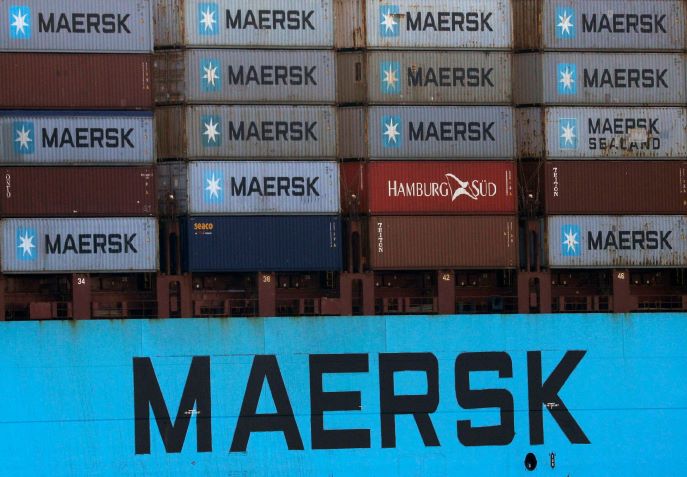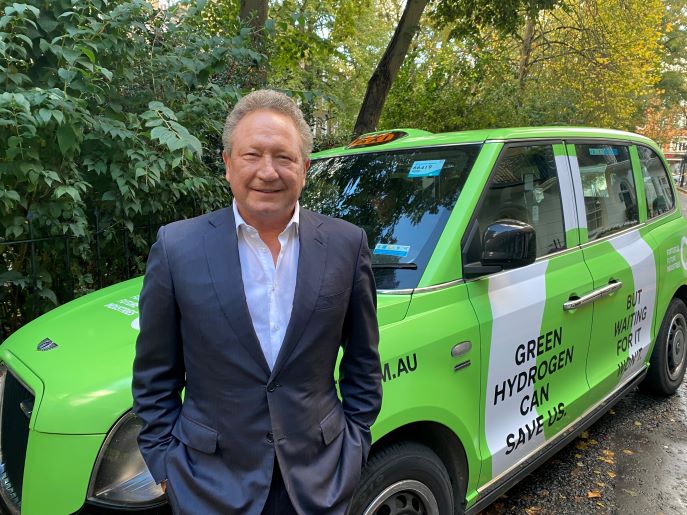With EU policymakers looking to quadruple investment in green hydrogen as they turn off the tap on Russian energy supplies, companies like Fortescue Future Industries will be looking to help fill the gap. Angeli Mehta reports
With the war in Ukraine forcing the European Union to cut its dependence on fossil fuels from Russia, one renewable technology that it will lean on to help fill the gap is green hydrogen.
Hydrogen produced using renewable energy such as wind and solar instead of natural gas, is viewed as key to decarbonising sectors such as steel, shipping and chemicals. Earlier this month, as part of its RePowerEU plan to replace Russian fossil fuel imports, the Commission said it wants to quadruple the existing target in its “Fit for 55” climate plan from 5 million tonnes to 20 million tonnes by 2030.
While 10 million tonnes will be sourced locally, a further 10 million will need to be imported, and the Commission announced a “hydrogen accelerator” programme to spur the development of the necessary infrastructure, storage and port facilities.
This is about getting started, learning, driving the cost down, and then increasing the scale
Several countries have already announced plans to become production and export hubs for green hydrogen, including Oman and Chile. But some of the biggest noise is coming from Australia, where there is a string of initiatives to develop gigawatt-scale solar and wind power projects to produce green hydrogen.
Just one company, Perth-headquartered Fortescue Future Industries (FFI), aims to be producing 15 million tonnes a year by 2030, and another 50 million a year in the 2030s.
Interviewed before the EU announcement, Julie Shuttleworth, FFI’s chief executive, said her company is securing projects across the world. “This is about getting started, learning, driving the cost down, and then increasing the scale,” she said.

FFI wants to decarbonise both its parent group operations (Fortsecue Metals consumed 700 million litres of diesel last year) and to make green hydrogen for others. Construction giant JCB in the UK and polymer producer Covestro in Germany, for example, have signed agreements to buy its green hydrogen.
“Demand is now much stronger than it was, so we’re very confident that we'll be able to sell it all. In fact, we don't think the world is going to be able to make enough for what we actually need by 2030.”
One of the big challenges is the vast amount of renewable energy required to power electrolysers used to produce green hydrogen. Jefferies Equities Research estimates that the EU’s new green hydrogen target will require another 90-150 gigawatts (GW) of electrolysis, in addition to the 30-50 GW already required in the Fit for 55 plan.
Alex Hewitt, founder and chief executive of Australian renewable energy developer, CWP Global, says just to produce the green hydrogen required for industry by 2050 we will need to double today’s global electricity output.
We’re running a lot of things in parallel, because this is such an emerging industry and lots of things need to be tested
For shipping alone, Hewitt estimates 40 renewable energy hubs of the 26 GW size he’s developing in Australia will be required. Investment will be in the trillions.
CWP and FFI are both founding members of the Green Hydrogen Catapult, a coalition of green hydrogen leaders convened by the United Nations High Level Champions for Climate Action. At COP26 catapult members – including Iberdrola, Yara and the Mærsk Mc-Kinney Møller Center for Zero Carbon Shipping – pledged to double electrolyser capacity by commissioning 45 GW of renewable energy by 2027.
That expanded deployment, if achieved, will bring the globe “very close to the gigawatts necessary to be aligned with 1.5C”, said FFI’s Shuttleworth.

FFI is proposing 5.4 GW of power to decarbonise the iron ore mining operations of Fortescue Metals, and to enable the production of green iron. (See ‘We’ll be producing green steel in commercial quantities by 2026’)
In February this year it began constructing an $83 million electrolyser manufacturing facility in Queensland, with an initial 2 GW capacity (enough to make more than 200,000 tonnes of hydrogen each year). The electrolyser technology was developed by Plug Power, but FFI is also working on its own.
“We’re running a lot of things in parallel, because this is such an emerging industry and lots of things need to be tested,” says Shuttleworth.
There are so many pieces of that puzzle that need to come together to have a proof of concept
She says the first projects in Australia are likely to be green ammonia projects, in part because ammonia is already transported around the world at scale. The company is scoping another Queensland project to enable an existing ammonia plant to run on green hydrogen, whilst a project with Australia’s research agency CSIRO is looking at cracking ammonia to convert it back to hydrogen at the point it is needed.
The world’s first liquified hydrogen carrier brought its first shipment (produced from brown coal) from Australia to Japan earlier this year. But green ammonia is seen as another potential technology to decarbonise the shipping industry, especially for long-distance routes as it’s easier to store and handle than hydrogen.
According to the U.N., zero-emission fuels will need to make up 5% of the fuel mix by 2030, if the shipping industry is to get on track to meet its 2050 decarbonisation targets.

Norway’s Yara, which makes (and transports) ammonia for agricultural fertilisers, plans to decarbonise its own production and help kick-start the green ammonia industry. One of its first projects is a solar-powered hydrogen plant being built by French firm Engie at its ammonia production site in western Australia’s Pilbara region, which is expected to begin production in 2023.
Extrapolating the demand from the shipping industry out to 2040/2050 means delivering enormous volumes of green hydrogen and ammonia, says Magnus Ankarstrand, who leads Yara’s newly formed clean ammonia business.
But, he adds, the key is not the first 5 million tonnes, but the first 50,000. “There are so many pieces of that puzzle that need to come together to have a proof of concept. It’s not only the engines and technology, it’s also logistics. You need to have the ammonia available to bunker, and no ship is going to take a detour to refuel, which means that we also need to work with ports to have the first fuelling stations established. So Yara is working to try to coordinate that work to enable the transition.”
Shipping is probably one of the most attractive markets to put green hydrogen into. You’ve got the scale of the demand, and certainty
Ankarstrand expects the first pilots to be running in 2024 and 2025, once engines are ready and safety standards agreed.
Last year, 22 governments signed the Clydebank Declaration, which set the goal of establishing at least six zero emission shipping routes (between two ports), by 2025.
The first green corridor, between Los Angeles and Shanghai, has already been announced.
“Shipping is probably one of the most attractive markets to put that green hydrogen into,” says Katharine Palmer, who is leading the U.N.’s High-Level Climate Champion’s team on shipping. “You’ve got the scale of the demand, and you’ve got the certainty; it’s not a market that's going to disappear.”

Some of the first movers are likely to be in container shipping, where the higher cost of clean fuel can be spread across individual items. In a series of initiatives, Yara, commodities trader Trafigura, alongside cargo owners including IKEA, Unilever and Amazon, have pledged to move cargo only on ships burning zero-carbon fuel by 2040. Yara has already agreed to provide clean ammonia fuel to Trafigura, and others.
Those are powerful signals, but policymakers will also have to play a role, says Ankarstrand, not least in enabling the development of the enormous quantities of renewable energy required. They will also have to help bridge the gap in costs between today’s fuel and tomorrow’s.
Trafigura and Maersk want to see dirtier fuels taxed, while the EU is mandating sustainable fuels and will bring maritime emissions into its emissions trading system.
The missing piece of the jigsaw is an accreditation system for green hydrogen that’s based on emissions intensity
The green corridors will be a great example of a “living lab”, where technology, policy and commercial frameworks can be tested, suggests Palmer.
The missing piece of the jigsaw is an accreditation system for green hydrogen that’s based on emissions intensity, says FFI’s Shuttleworth. Various initiatives are under way, including in the United States and Europe. Australia is trialling a hydrogen “guarantee of origin” scheme, while the Green Hydrogen Organisation, set up last year by the founder of Fortescue Metals, Andrew Forrest, plans to launch a standard in May.
Green hydrogen developers are concerned to differentiate themselves from proponents of another colour of hydrogen: blue. Blue hydrogen is made from natural gas, using carbon capture and storage (CCS) to tackle the CO2 emissions produced by the process. CCS doesn’t capture 100% of emissions, and the original source of the gas will have varying global warming impacts depending on the extent of flaring and methane leakage.

But backers, including Yara, argue it will allow the world to ramp up hydrogen supplies more quickly, and speed the reduction of carbon emissions while renewables expand.
That assessment, says Yara’s Ankarstrand doesn’t change even with the war on Ukraine, although “it is difficult to judge the long-term effects on gas pricing”.
However, in January, before the conflict began, the International Renewable Energy Agency suggested green hydrogen would be cheaper in most key markets by the end of the decade. An analysis by BloombergNEF suggests war has pushed up prices to the extent that not only is green hydrogen cheaper than blue, but it is now less expensive even than unabated grey hydrogen.
Angeli Mehta is a former BBC current affairs producer, with a research PhD. She now writes about science, and has a particular interest in the environment and sustainability. @AngeliMehta.
This article is part of The Ethical Corporation’s March 2022 Energy Transition briefing: See also:
As energy security concerns trump climate, will drive to cut methane be derailed?
Why indigenous people could be critical to ensuring EV doesn’t run out of road
The rising tide of climate litigation that is lifting all boats
Activist investors vow to keep climate in their sights, despite war in Ukraine
‘We’ll be producing green steel in commercial quantities by 2026’
Will Ukrainian crisis help bring nuclear in from the cold?
Weather set fair for offshore wine in U.S.
New life injected into ambition of capturing CO2 from air
Carbon capture gains ground, but still ‘drop in the bucket’ in getting to net zero
Fortescue Future Industries green hydrogen REPowerEU Russian gas Yara Maersk Trafigura green ammonia shipping industry zero-emission fuels Clydebank Declaration


